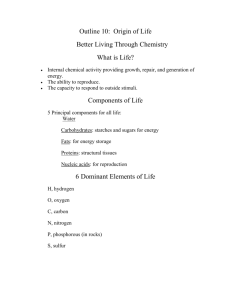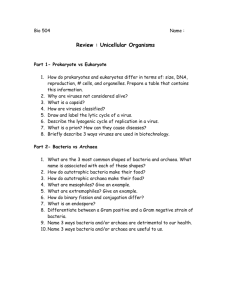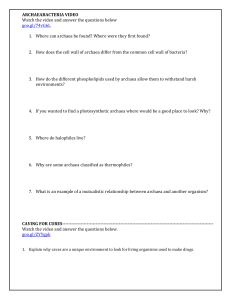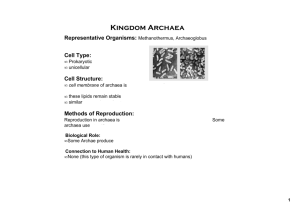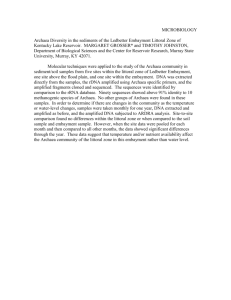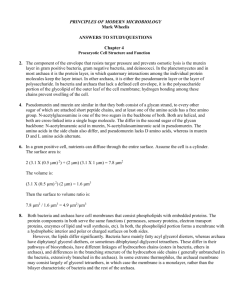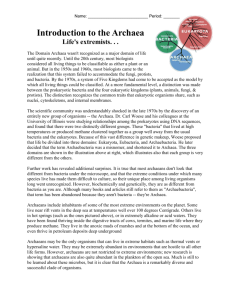Archaea Lesson - Yellowstone Teacher Project
advertisement
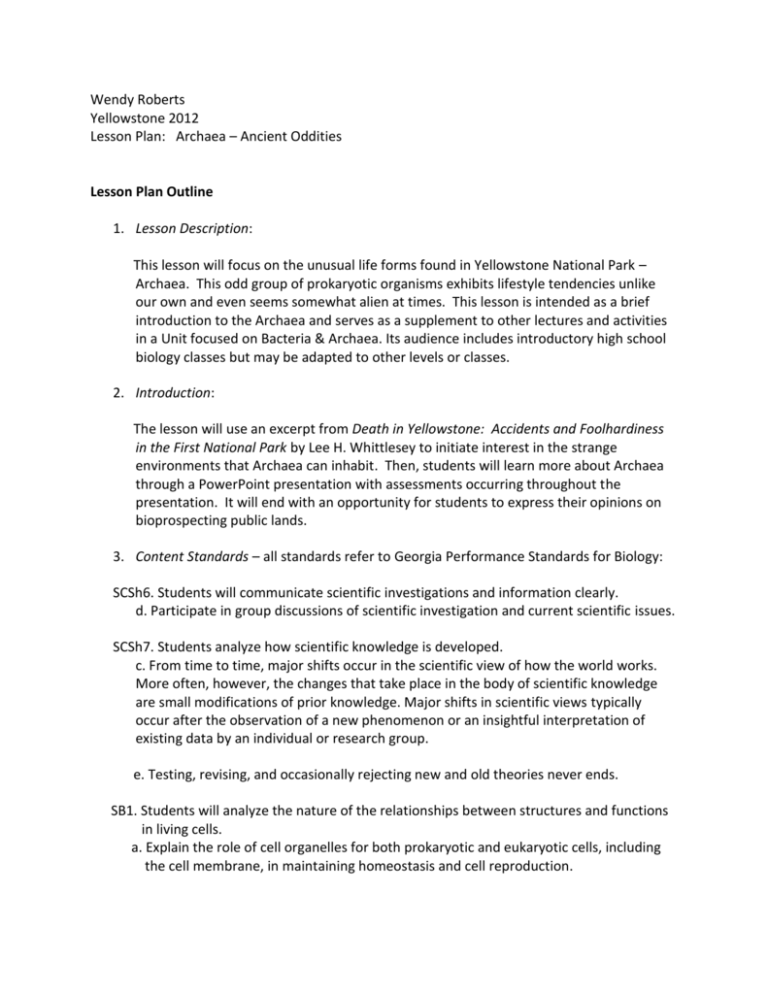
Wendy Roberts Yellowstone 2012 Lesson Plan: Archaea – Ancient Oddities Lesson Plan Outline 1. Lesson Description: This lesson will focus on the unusual life forms found in Yellowstone National Park – Archaea. This odd group of prokaryotic organisms exhibits lifestyle tendencies unlike our own and even seems somewhat alien at times. This lesson is intended as a brief introduction to the Archaea and serves as a supplement to other lectures and activities in a Unit focused on Bacteria & Archaea. Its audience includes introductory high school biology classes but may be adapted to other levels or classes. 2. Introduction: The lesson will use an excerpt from Death in Yellowstone: Accidents and Foolhardiness in the First National Park by Lee H. Whittlesey to initiate interest in the strange environments that Archaea can inhabit. Then, students will learn more about Archaea through a PowerPoint presentation with assessments occurring throughout the presentation. It will end with an opportunity for students to express their opinions on bioprospecting public lands. 3. Content Standards – all standards refer to Georgia Performance Standards for Biology: SCSh6. Students will communicate scientific investigations and information clearly. d. Participate in group discussions of scientific investigation and current scientific issues. SCSh7. Students analyze how scientific knowledge is developed. c. From time to time, major shifts occur in the scientific view of how the world works. More often, however, the changes that take place in the body of scientific knowledge are small modifications of prior knowledge. Major shifts in scientific views typically occur after the observation of a new phenomenon or an insightful interpretation of existing data by an individual or research group. e. Testing, revising, and occasionally rejecting new and old theories never ends. SB1. Students will analyze the nature of the relationships between structures and functions in living cells. a. Explain the role of cell organelles for both prokaryotic and eukaryotic cells, including the cell membrane, in maintaining homeostasis and cell reproduction. SB3. Students will derive the relationship between single-celled and multi-celled organisms and the increasing complexity of systems. b. Compare how structures and function vary between the six kingdoms (archaebacteria, eubacteria, protists, fungi, plants, and animals). c. Examine the evolutionary basis of modern classification systems. 4. Objectives: 1. The student will discover the unique ecosystems in Yellowstone National Park. 2. The student will determine the difficulties of living in geothermal springs. 3. The student will analyze the structure of Archaea that makes this organism suited for unusual environments. 4. The student will explore the different groups of Archaea. 5. The student will devise a plan to address bioprospecting in public areas. 5. Time Required: Day One: Activity 1: (15 minutes) – The instructor will read excerpts (pp. 9 -10, pp. 16 -17, and pp. 20 – 26) of Death in Yellowstone: Accidents and Foolhardiness in the First National Park by Lee H. Whittlesey. The instructor will discuss the harsh conditions of the geothermal areas and the difficulties in living in these environments. Students will hypothesize as to whether any life can survive there and if so, how? Activity 2: (40 minutes ) – The PowerPoint Presentation “Archaea: Ancient Oddities” will be presented to the students. As the teacher discusses each slide in depth with the students, the learner will answer self-check questions along the way. Activity 3: Students will complete Self-Check Question #10: Do you think federal lands should be open for bioprospecting? Defend your answer in 2 well-written paragraphs (5-7 sentences each). Day Two: Activity 1: (5 - 10 minutes) – Students will work with a partner to critique each student’s homework. Activity 2: (30 minutes) – As a class, a general set of guidelines will be developed for bioprospecting in National Parks. Robert’s Rules of Order will be used to generate a class consensus on the plan with all parties signing the agreement. 6. Materials: Whittlesey, Lee H. (1995). Death in Yellowstone: Accidents and foolhardiness in the first National Park. Landham, MD: Roberts Rinehart Publishers. Archaea: Ancient Oddities Powerpoint 7. Assessment: Archaea: Ancient Oddities Self-Check Questions 8. Extensions: Students visit a local bog to explore habitats for Archaea closer to home. Students create a scrapbook of Archaea habitats using computer-based technology. Students create a food chain of Archaea in deep-ocean vents and relate this to early life forms. 9. Interdisciplinary Features: Language Arts – Students will develop technical writing skills in their Bioprospecting Consortium. Technology – Students will use computers to generate their scrapbook.
